SteemSTEM Science fair Entry: beautiful sugar crystals for kids
Trying to get our children interested in science can be at the same time extremely simple and complex. Here I present a chemistry experiment I realised with our son of 6 years old, but that may also be suitable for bigger kids.
Starting question
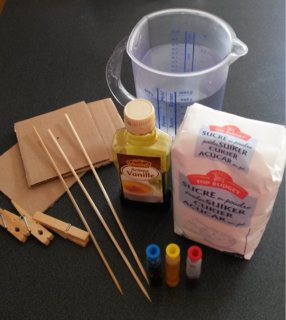
[image credits: homemade]
What happens to sweetened water (a mix of water and sugar, nothing less nothing more) when it is first heated and next cooled down?
Material needed for the experiment:
- 380 g of water
- 1 kg of granulated sugar (or about 1 cup of water for 3 cups of sugar)
- wooden sticks (like skewer)
- clothes pegs
- long drink glasses
Optional: food coloring, food flavor
Step 1: Preparation of the material
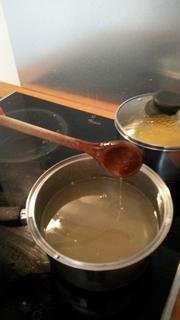
[image credits: homemade]
Wet the sticks and roll them into the sugar: let then them dry on a plate. Some use a string with a paper clip attached to one of the ends, but I prefer the solid support of a stick which then allows to reuse the sugar crystals for a real meal / drink.
If desired, put a few drops of food coloring into the glasses and / or artificial flavor. The visual effect is much more beautiful and the aroma brings a touch of fantasy.
Step 2: Dissolution of sugar crystals
Heat the water and gradually add the sugar. Dissolve the sugar by mixing with a wooden spoon until the solution is completely saturated.
Step 3: Final installation and cooling
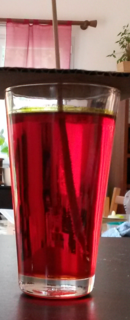
[image credits: homemade]
Once the sugar has completely dissolved, pour the syrup into the glasses.
Let cool and soak the spikes in the glasses, keeping them in the center with a clothes peg.
To protect the crystals from the dust, I cut out squares of cardboard with a hole in the center to let pass the sticks as in the image.
The spikes must not touch the edges or the bottom of the glass.
Then install the glasses in a place where they will remain motionless for the rest of the experience.
Questions to Zachary (6 years old) and his impressions
What happens to sugar when mixed with water?
The sugar dissolves in water and is transformed. It becomes sweet water.
Can we do the same experiment with cold water?
In cold water, if you put sugar, there comes a time when it will overflow. It dissolves less and less quickly. While in hot water, it does not overflow because it dissolves very quickly and one can put more.
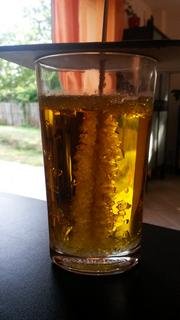
[image credits: homemade]
Observations made at day-3:
The crystals formed on the stick that was put in the water and also on the surface of the liquid.
Observations made at day-7:
The longer you wait, more crystals are formed ... The crystals are big enough, we can get them out of the water.
What happened ? Where do the crystals come from? How have they formed?
When the water was very hot we could not see the sugar and when it got cold, it became crystals.
Scientific explanation of the phenomenon
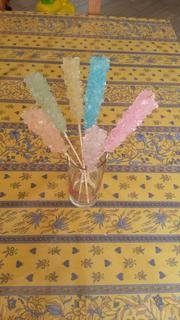
[image credits: homemade]
Sugar consists of sucrose molecules that are linked together. When they encounter water molecules, the latter bonds break down to form new molecules. The solid crystal sugar disappears: it is said to be dissolved.
By heating the water, we increase the amount of sugar that can be dissolved.
When the temperature decreases, the agitation of the molecules also decreases and the sugar is found in too great quantity compared to the amount of molecules of water. The sucrose molecules bind together again on surfaces such as the glass walls, the string, the trombone or the stick.
This consists of crystal formation.
For children, one can compare the binding of water molecules to sugar with two groups of children meeting. A group of very numerous girls meet a group of boy (less numerous) who will mix with each other.
When the water boils, the children run in all directions, everyone is mixed and when the children get tired (the water that cool down), the groups are formed again: some groups will be composed of girls and boys (sweet water), but since there are more girls, some will remain together and form the « crystals ».
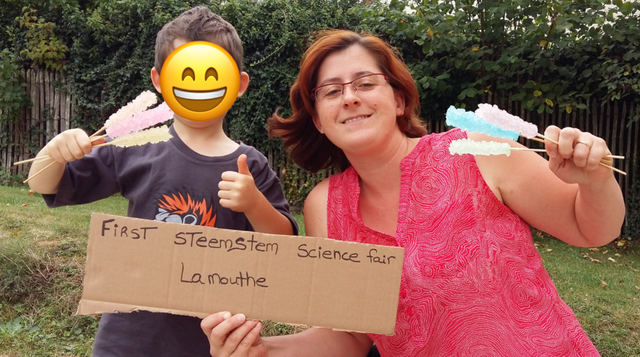
[image credits: homemade]
Thanks for sharing, this project for sciencefair looks a total unique and a interesting one. Should be trying in the upcoming days .
Wish you have as much fun as my son had! ;)
Those sugar crystals came out great!
With the colours and the flavour, the result is very nice looking (and tasting ;) )
This works well for the coffee :)
or tea ;)
This will sound dumb, but who account is this??? You are active on the post, RS it and the spelling is almost like your name here on this other account LOL
'le' = 'the' (male) and 'la' = 'the' (female). This is actually my wife's account ;)
I wondered if that might be it!!!
My G. 10 French skills are still on point!
LOL
The next step is to read my posts in French :)
Man, that would not be productive for me dude
LOL
As English versions are always available, you could see it as a free French lesson :D
Interestingly, we must show our children. Thank you for your good post.
Very awesome experiment @lamouthe, it has to be practice for me
Rock candies, I love them!!! Thank you for join the sciencefair too!!
its time to cook, going breaking bad
The joys of science - rock candy. Next lesson, cotton candy. Thanks for post.
I don't know how to do cotton candy? Do you have a link to give me ? It coud be very funny to!
The most common way that I know of is with a machine. Since you are trying to do this with your kids, I remember seeing an article doing it without a machine. I found it here -
http://archive.jsonline.com/features/food/make-homemade-cotton-candy-without-a-machine-b99468565z1-298509201.html
Have fun and make sure the kids brush their teeth. Have a nice day.
Excellent!!! thank you for the link. I'll take a look to try this with my son :)
I glad it works for you.
Here I feel there is an interesting to in understand,thank you continue